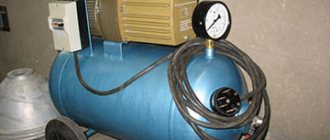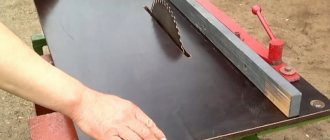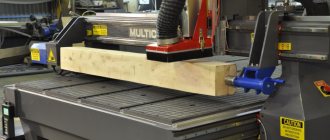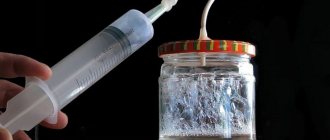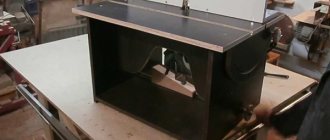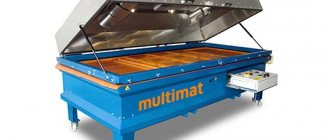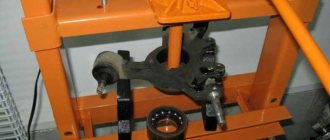Opening a small furniture manufacturing enterprise begins with the acquisition of the necessary equipment.
It’s good if you have the opportunity to purchase branded factory-made machines.
But what if the starting capital is very limited?
There is only one way out - to assemble some of the units yourself. You can, for example, make a vacuum press with your own hands.
Operating principle of a vacuum press
The price of a vacuum press is not affordable for many enterprises, but those who can purchase such a device regularly save money, because laminating a work surface in your own workshop is much cheaper than purchasing a ready-made workpiece. This equipment includes:
- Chamber for pressing.
- Thermal module.
- Silicone membrane for a vacuum press.
- Vacuum pump.
During operation of the device, a workpiece and a film are placed deep into the chamber, which is heated, thanks to the thermal module, and under vacuum pressure is glued to the MDF surface, repeating all the contours of the product.
The membrane-vacuum press looks like an all-metal, durable metal frame, due to which the service life of the equipment is not limited. In addition, the device has an attractive appearance thanks to powder painting, which additionally protects the structure from external influences.
Also, the vacuum membrane press is equipped with a work table made of imported high quality propylene. Its thickness is 15 mm. Thanks to this characteristic, it is able to withstand daily prolonged heating up to 80˚C, but does not damage the workpieces and the membrane of the vacuum press.
The membrane for the vacuum press is made of silicone that has undergone preliminary degassing. Its thickness is 2 mm. Thanks to these characteristics, it is able to withstand high temperatures inside the chamber and perform its function.
The vacuum press pump performs one of the main functions during operation of the device. When the material used is heated to a certain temperature, the device turns on the vacuum pump for the press. Due to this, a vacuum space is created inside the chamber and air is pumped out, which prevents the laminating film from being soldered to the outside of the workpiece.
3d vacuum sublimation press
A vacuum sublimation press, also called a 3d vacuum sublimation press, is a type of press that creates a vacuum. It is designed for applying images to smooth or distorted surfaces. In fact, a 3D vacuum press works similarly to a vacuum membrane press, namely, thanks to:
- High temperature.
- Vacuuming.
Most often, vacuum 3D presses are used for the production of souvenirs, because the device allows you to apply images to ceramics, fabrics, plastics, crystals, natural stones, etc. Consequently, as a result, enterprises receive unique, beautiful, original products that are in demand in various fields, ranging from gifts to dishes and bathroom tiles.
Clamps
To hold the film securely and airtight when vacuum pressing occurs, we press the top frame tightly and evenly against the perimeter of the vacuum frame. This way the rubber seal will fit completely.
Homemade clamps, which operate on the eccentric principle, are made from the following rolled steel:
• 1 pipe DN50: 0.5 m, with an outer diameter of approximately 60 mm; • rod: 2 m, diameter 10 mm; • profile pipe: 2 m, 20x20x2 mm.
We adjust the clamps by installing combination nuts in the desired location on the stud thread and securing them with locknuts. This operation is performed at the final stage of manufacturing the vacuum table, after the rubber seal has been glued.
Learn how to create several tons of pressure per square meter when gluing veneer.
Working with veneer is much easier than you think if you use a vacuum press to compress the glue. To introduce our readers to this process, we turned to professional furniture maker Matt Sailer, who often uses veneer in his work.
According to Matt, veneer offers several advantages.
“It allows you to change the direction of the grain pattern on the facing surfaces and even mix different species, which is difficult and sometimes impossible to do with solid wood. Companies that produce and sell veneer offer products from hundreds of wood species and a huge variety of patterns and shades. This palette is simply amazing.”
WHAT IS NEEDED FOR VACUUM PRESSING
How does this system work?
The vacuum bag evenly distributes significant pressure over a large area, even over concave and convex surfaces, which is difficult and sometimes impossible to achieve with conventional methods. When air is pumped out of a sealed bag, the pressure from outside air compresses the bag and its contents. If you think that such a clamp will be too weak, keep in mind the following: a panel measuring 610x915 mm inside the bag is compressed with a force of about 5.5 tons (if the process occurs at sea level. With increasing altitude, atmospheric pressure decreases, and at an altitude of 1500 m above sea level the force will be 4.8 t).
The photo below shows the main elements of the vacuum system. A basic set of pump, hose with fittings and vinyl bag measuring 125x125 cm can be purchased for S400. To veneer long panels (such as in the Sixties Cabinet project), you need a bag measuring 125x250 cm. A vinyl bag of this size costs about $75, and a more durable polyurethane bag will cost $215. Although the vacuum bag creates a fair amount of pressure, unadhered areas and swellings (so-called “siskins”) may be found on the veneer if additional measures are not taken. Matt makes a "sandwich" by sandwiching the veneer panel between two pressure plates to distribute the pressure more evenly.
Read also: Tour tower useful life
Make these plates from 19mm MDF board or laminated chipboard. Their dimensions should be approximately 25 mm larger than the package of parts. Mill 6mm fillets on all edges and corners to avoid damaging the vacuum bag. On one of the plates, use a saw blade to make a grid of 3 mm cuts with a pitch of about 100 mm. This will help completely pump the air out of the bag.
Do not use contact glue. Contact adhesive is considered the best choice for gluing sheets of plastic, but Matt recommends avoiding it if you're gluing wood to wood: "Under veneer, contact adhesive dries out, causing edges and corners to pull away from the backing and become easily damaged."
Choice of base and glue
For strong bonding, veneer requires a smooth surface called a base or substrate. MDF board is excellent for use as a base for panels such as doors, false panels and countertops. For the panels on which the joints are then made, choose maple, beech or birch plywood. “But oak plywood should not be used,” says Matt, “its large pores will show through the thin veneer after pressing.” Since you will be sawing the panels to final dimensions after gluing the veneer, make the base, including the edge caps, approximately 12 mm larger in width and length. The glued overlays must be at least 25 mm wide so that after filing there is enough material left for routing the profiles along the edges.
If you want to cover a panel smaller than 60x60cm with one piece of veneer, you can use regular yellow PVA glue. For larger areas, or if the shirt is assembled from several pieces of veneer, Matt uses a special one-component cold-press adhesive. “It lasts longer so you can work without fuss, and the increased viscosity reduces glue bleed through seams.” Some manufacturers offer light, medium and dark varieties of this glue, and this helps make the glue lines less noticeable.
How to cut veneer
To cut veneer, Matt uses three simple tools: a sharp knife with a retractable blade (for cross cuts), a so-called plywood saw (for rip cuts), and a steel ruler to guide them (photos A and B). Quick tip! Place a strip of 150-grit sandpaper on the underside of the ruler to keep it in place as you work. Place the veneer sheet on a piece of MDF board to avoid leaving scratches on the workbench cover when cutting. Press the ruler against the veneer as tightly as possible to prevent movement. For best results, do not try to cut the veneer in one motion, but make several long, light cuts along the edge of the ruler.
When cutting veneer across the grain, make cuts from both edges to the middle to avoid splitting the edges. Change blades frequently to keep them razor sharp.
For longitudinal cutting in a straight line, use a plywood saw instead of a knife (the blade of the knife often deviates from the ruler in the direction of the grain). Move the tool towards you and make a few light cuts to cut right through the veneer.
If the panel is large, to cover it you have to glue together several pieces of veneer (“pick up a shirt”). To do this, lay the veneer strips face down on a workbench, align and join the cut edges. Make sure that the texture pattern at the junction of the stripes looks the way you want. Then place pieces of masking tape across the joint to temporarily hold the veneer strips together (Photo C).
Turn the shirt over and place a long strip of tape along the seam line on the front side (photo D ).
Apply short strips of masking tape across the joint at intervals of about 10cm to ensure the veneer sheets fit together as tightly as possible.
With the sheets together on the back side, apply a long strip of tape along the seam to the front side (which will be visible on the finished panel).
This will prevent excess glue from squeezing out onto the front side through the seam, and you will spend less time removing it after you remove the panel from the vacuum bag. Turn the veneer over again and remove the short pieces of tape. Quick tip! The strips of tape should not overlap each other, and there should be no wrinkles or folds on them, so that during pressing, dents do not appear on the veneer.
Don't forget the other side
Because the adhesive dries first at the edges of the panel and then in the middle, the difference between the dry edges and the wet middle creates stresses that can arch even a 19mm base. By gluing veneer to both sides of the panel, the stresses will be balanced and the panel will remain flat. Matt says: “The veneer for the back doesn't have to be anything special, and you can use any inexpensive grade of veneer. But it must be glued to the base at the same time as the face veneer, using the same glue.”
Let's start pressing
Orient the veneer shirts as they should be placed on the base. Protect the sides of the pressure plates that will be in contact with the veneer with wax paper, securing its edges with tape. Apply glue to the back of the base (not the veneer!) as shown in Photo E. (If you smear the veneer, it will curl up and be difficult to straighten.) Excess glue from the base can be easily and quickly removed with a putty knife.
To quickly and evenly apply the glue, Matt uses a rubber roller. Having poured the glue from the bottle, he rolls it with a roller over the entire base, leaving no dry spots.
Place veneer on the back side and level it. Its edges may begin to curl into a tube from moisture that is absorbed from the glue. Matt secures these edges with short strips of masking tape. Then flip the panel over, placing it back on the pressure plate, and glue the veneer to the front side. Place a pressure plate with cuts on top of the panel and place the entire “sandwich” in a vacuum bag (photo F ). After straightening out all the folds on the bag, fold the edge, put on the clasp and turn on the pump. “I haven’t seen a bag that’s completely sealed yet,” says Matt, “so keep an eye on the pressure and don’t turn off the pump until the glue dries.” After about an hour, turn off the pump and remove the contents from the bag. Carefully remove the masking tape so that it does not stick to the veneer due to the excess adhesive squeezed out (photo G). Place the panel and pressure plates back into the bag, turn on the pump and leave the glue under pressure for another three hours.
Read also: Tool for cutting round holes in wood
Place the pressure plates with the panel and veneer in a bag. To effectively remove air, the fitting with the valve must be located at the intersection of two cuts (photo insert).
The glue has barely set, so be careful not to pull the veneer away from the base. Pull the tape away from the joint to avoid tearing out individual fibers.
Processing the panel after the press
When the glue has dried, trim one edge with a sharp chisel or knife (photo H). Then saw the panel to final dimensions (Photo I).
Lightly cut away the exposed veneer on both sides of the panel to create a smooth edge to fit the rip fence of the machine.
To reduce chipping on the ends and edges of the panel, apply masking tape along the cutting line to support the veneer fibers when sawing.
Almost invisible repair
Do not despair if an edge or corner of the veneer breaks off when trimming overhangs or filing a panel. “It happens,” Matt says, “but repairs are a lot easier than you think.”
First of all, from the remaining veneer, select a piece whose color and texture pattern matches the damaged area. The greater the similarity, the less noticeable the patch will be. Cut the patch slightly larger so that the edge is parallel to the grain or at an angle (Photo J ). A joint perpendicular to the grain is difficult to make invisible.
Place the patch on the damaged area and run the corner of a chisel along its edge, cutting into the veneer. Then, starting from the edge of the panel, remove the veneer up to the score line (photo K). Reapply the patch and secure it temporarily with tape. A small piece of tape will allow you to see the joint and make sure the fiber pattern matches. If you are happy with the appearance, lift the patch, apply glue (photo L) and press the patch again (photo M), leaving the clamp in place for at least two hours. After sanding, the repair site will not be easy to locate (photo N).
Cut the patch slightly larger and sand or file a straight edge at an angle to the grain to make the joint less noticeable. Determine the exact position of the patch.
Using a sharp chisel, deepen the cut to completely cut through the glued veneer. Then carefully remove the damaged veneer.
Once the patch has been accurately aligned, place a strip of masking tape across the joint. Lift the patch, apply glue to the backing, then apply the clamp.
A clamp made from a piece of MDF board distributes pressure evenly and the patch does not move. The wax paper will prevent the trim from sticking to the veneer.
Thanks to the careful selection of the grain pattern and the perfect line of junction of both parts, the patch is difficult to detect.
The vacuum press is a unit that allows you to produce various furniture facades with PVC film based on MDF, as well as decorative door trims. You can buy it in a specialized store or make it yourself at home. It is necessary to remember that if you decide to make such equipment with your own hands, you will need to try very hard, observing all safety rules.
Vacuum press for MDF
A modern vacuum press for MDF is equipped with a control panel and a temperature control thermostat, thanks to which specialists can control the process of cladding furniture, kitchen facades and doors. Additionally, vacuum presses for MDF have a shutdown button, which is used to instantly turn off all devices of the device in the event of a sudden breakdown.
When operating a vacuum press, the operator must adhere to the following operating pattern:
- Place the workpieces on the work surface.
- Stretch the desired film along the entire length of the working area.
- Move the upper movable section of the devices.
- Turn on the device and monitor the processing process.
- Remove the finished product by hand.
That is, the device is easy to use, so employees of the enterprise will quickly learn how to work with the device or understand how it differs from the previous model of the vacuum press that was in your workshop.
Vacuum presses for facades
A vacuum press for facades is used for the production of veneer and sandwich panels installed outside the living space as insulation, but sometimes, thanks to this device, a relief surface is created on panels intended for external cladding.
Vacuum presses for facades can be:
- Membrane. Allows surface treatment under high temperatures.
- Membraneless. Used for surfaces with a high density coefficient.
Blanks that have undergone press processing take on a neat appearance and improve the quality of the finished product. In addition, ready-made blanks do not require re-processing or modification, so they can be used immediately after removal from the device and cooling.
Main varieties
Today, two types of vacuum presses are produced:
In a conventional press, the facing material is pressed against the part by atmospheric pressure, and in a press with excess pressure, compressed air is additionally pumped into the cavity above the workpiece
Equipment of the first type is used in cases where it is necessary to cover products with a simple configuration with PVC film or veneer. Vacuum presses capable of creating high pressure are used for veneering or covering with PVC film parts of complex shapes. In addition, such equipment is often used as a vacuum molder, with the help of which three-dimensional products of various configurations are made from sheet plastic.
The most common two layout options for vacuum presses are:
Where to buy a vacuum press
Today it is very easy to buy a vacuum press, because modern technologies allow you to purchase goods without leaving your home.
What to look for if you want to buy vacuum presses:
- Manufacturer of the design.
- Device dimensions.
- The price for vacuum presses should be average, because cheap devices may have a short warranty period, and expensive ones are unlikely to have better quality than designs included in the average price category.
The advantage of buying online is that the buyer can view the product remotely, compare prices, spending a minimum of time, but if you want to save on buying a vacuum press, you can make it yourself.
DIY vacuum press
Making a vacuum press with your own hands is a complex procedure that requires the ability to work with heavy materials and dangerous equipment, therefore, before you start making a pressing device, you should evaluate your abilities. In addition, incorrect assembly of the structure can lead to a sudden fire or injury to the craftsman, so it is recommended to purchase a ready-made structure rather than making it without special technical knowledge, skills and abilities.
Construction drawing
This version of a homemade vacuum press is supposed to be equipped with a recoil-type thermal module (see diagram below).
Other types of heaters - lifting and swing - are more difficult to manufacture and less convenient to use. The thermal module is equipped with rollers (ball bearings) and moves on rails (20x20 pipe). There is a parking space for it on the frame.
The dimensions chosen for the vacuum chamber are 2.5 x 1.4 m. This length is optimal for the manufacture of the most typical furniture facades, and the width corresponds to the most common type of PVC film.
Vacuum press drawing
It is intended to load parts with a thickness of no more than 32 mm into the chamber, so its height, taking into account the thickness of the linings, air-permeable platform and seals, is taken to be 60 mm (made from a pipe 60x40x2 mm).
